Investigations on the Influence of Total Water Hardness and pH Value on the Measurement Accuracy of Domestic Cold Water Meters
Abstract
:1. Introduction
2. Background
2.1. Cold Water Meters
2.2. Water Quality Parameter: pH Value
2.2.1. Low pH Value
2.2.2. High pH Value
2.3. Water Quality Parameter: Hardness
2.3.1. Low Hardness (Soft Water)
2.3.2. High Hardness (Hard Water)
3. Boundary Conditions and Procedure
3.1. Accelerated Wear Test
3.2. Water Meter Calibration—Before and after
3.3. Test Conditions of the Accelerated Wear Test
3.3.1. Water Temperature
3.3.2. Flow Rate and Pressure
4. Test Water Preparation
4.1. pH Value Experiments
- pH value low: pH ;
- pH value medium: pH ;
- pH value high: pH .
4.2. Hardness Experiments
- Hardness low (soft water): less than mmol −1 calcium carbonate;
- Hardness medium: 1.5 mmol −1 to 2.5 mmol −1 calcium carbonate;
- Hardness high (hard water): more than mmol −1 calcium carbonate.
- Hardness low: 1 mmol −1 calcium carbonate ( );
- Hardness medium: 2 mmol −1 calcium carbonate ( );
- Hardness high: 3 mmol −1 calcium carbonate ( ).
4.3. Chemicals
4.4. Base Model Water (MW)
4.5. Highly Purified Water (HPW)
4.6. Test Waters
5. Measurement Set-Up
5.1. Calibration Facility
5.2. Accelerated Wear Test facility
5.2.1. Operating Principle
5.2.2. Acquired Measurement Data
- (a)
- Temperature compensated pH value measurements in a range from 0 to 14; resolution: pH ; accuracy: pH ;
- (b)
- Temperature compensated water hardness measurements in a range from 0.1 to 40 ; resolution: (optional: ); accuracy: ±5%);
- (c)
- Temperature compensated conductivity measurements in a range from 0 cm−1 to 2000 cm−1; resolution: 1 cm−1; accuracy: below ±1%.
- (a)
- pH Value Sensor
- (b)
- Hardness Sensor
- (c)
- Conductivity Sensor with in-Built Temperature Sensor
6. Measurement Results
6.1. Calibration of the Water Meters before the Wear Test
- Flow rate: to 1.1 ;
- Flow rate: to 1.1 ;
- Flow rate: 0.33 ( + ) to 0.37 ( + );
- Flow rate: 0.67 ( + ) to 0.74 ( + );
- Flow rate: 0.9 to ;
- Flow rate: 0.95 to .
6.1.1. Multi-Jet Cold Water Meters (B Meters)
6.1.2. Ultrasonic Cold Water Meters (Kamstrup)
6.2. Accelerated Wear Tests
6.2.1. pH Value Measurements
6.2.2. Total Hardness Measurements
6.2.3. Conductivity Measurements
6.3. Re-Calibration of the Water Meters after the Wear Test
6.3.1. Multi-Jet Cold Water Meters (B Meters)
6.3.2. Ultrasonic Cold Water Meters (Kamstrup)
7. Conclusions and Discussion
Author Contributions
Funding
Institutional Review Board Statement
Informed Consent Statement
Data Availability Statement
Conflicts of Interest
Abbreviations
| ASTM | American Society for Testing Materials |
| CMI | Czech Metrology Institute |
| DIN | Deutsche Industrienorm (German Institute for Standardization) |
| DVGW | Deutscher Verein des Gas- und Wasserfaches e.V. (German Technical and Scientific Association for Gas and Water) |
| EC | European Commission |
| EEC | European Economic Community |
| EMC | Electromagnetic Compatibility |
| EMPIR | European Metrology Programme for Innovation and Research |
| FNU | Formazin Nephelometric Unit |
| HPW | Highly Purified Water |
| IMD | Individuell mätning och debitering (Individual metering and billing) |
| ISO | International Organization for Standardization |
| JRP | Joint Research Project |
| MID | Measuring Instruments Directive |
| MPE | Maximum Permissible Error |
| MW | Model Water |
| NMI | National Metrology Institute |
| OIML | International Organization of Legal Metrology |
| PTB | Physikalisch-Technische Bundesanstalt (The National Metrology Institute of Germany) |
| QMS | Quality Management System |
| RISE | Research Institutes of Sweden |
| SL | Stock Solution |
| TZW | DVGW-Technologiezentrum Wasser (German Water Centre) |
| VM7 | Vattenmätbänk no. 7 (calibration facility at RISE) |
| WELMEC | Western European Legal Metrology Cooperation |
| WRMG | Wasch- und Reinigungsmittelgesetz (Washing and Cleaning Agents Act) |
References
- The European Parliamente and the Council of the European Union. Directive 2004/22/EC on Measuring Instruments. Official Journal of the European Union, L 135/3. 2004. Available online: https://eur-lex.europa.eu/legal-content/EN/TXT/HTML/?uri=CELEX:32004L0022&from=EN (accessed on 23 September 2021).
- The Council of the European Communities. Council Directive 75/33/EEC on the Approximation of the Laws of the Member States Relating to Cold-Water Meters. Official Journal of the European Communities, L 14/1. 1974. Available online: https://op.europa.eu/en/publication-detail/-/publication/916e0da6-a11b-4dfd-aaa4-839fc68e5b47/language-en (accessed on 23 September 2021).
- The European Parliamente and the Council of the European Union. Directive 2014/32/EU on the Harmonisation of the Laws of the Member States Relating to the Making Available on the Market of Measuring Instruments (Recast). Official Journal of the European Union, L 96/149. 2014. Available online: https://eur-lex.europa.eu/legal-content/EN/TXT/HTML/?uri=CELEX:32014L0032&from=EN (accessed on 23 September 2021).
- The European Parliamente and the Council of the European Union. Directive (EU) 2020/2184 on the Quality of Water Intended for Human Consumption (Recast). Official Journal of the European Union, L 435. 2020. Available online: https://eur-lex.europa.eu/legal-content/EN/TXT/HTML/?uri=CELEX:32020L2184&from=EN (accessed on 23 September 2021).
- The Council of the European Union. Council Directive 98/83/EC on the Quality of Water Intended for Human Consumption. Official Journal of the European Union, L 330/32. 1998. Available online: https://eur-lex.europa.eu/legal-content/EN/TXT/HTML/?uri=CELEX:31998L0083&from=EN (accessed on 23 September 2021).
- Banks, D.; Birke, M.; Flem, B.; Reimann, C. Inorganic chemical quality of European tap-water: 1. Distribution of parameters and regulatory compliance. Appl. Geochem. 2015, 59, 200–210. [Google Scholar] [CrossRef]
- Flem, B.; Reimann, C.; Birke, M.; Banks, D.; Filzmoser, P.; Frengstad, B. Inorganic chemical quality of European tap-water: 2. Geographical distribution. Appl. Geochem. 2015, 59, 211–224. [Google Scholar] [CrossRef]
- Zenner. Zenner Informiert—Über das Messverhalten und die Dimensionierung von Wasserzählern & Informationen zur MID Measurement Instrument Directive; Zenner International GmbH & Co. KG: Saarbrücken, Germany, 2011. [Google Scholar]
- Swedac. Sveriges Vattenleverantörer har Sina mäTare under Kontroll. 2020. Available online: https://www.swedac.se/sveriges-vattenleverantorer-har-sina-matare-under-kontroll (accessed on 19 June 2021). (In Swedish).
- Swedac. STAFS 2007:2—Swedacs Föreskrifter och Allmänna råd om åTerkommande Kontroll av Vatten- och väRmemätare. 2007. Available online: https://www.swedac.se/wp-content/uploads/2016/06/STAFS-2007_2-konsol.pdf (accessed on 19 June 2021).
- The European Parliamente and the Council of the European Union. Directive 2012/27/EU on Energy Efficiency. Official Journal of the European Union, L 315/1. 2012. Available online: https://eur-lex.europa.eu/legal-content/EN/TXT/HTML/?uri=CELEX:32012L0027&from=EN (accessed on 23 September 2021).
- DVGW. Technische Regel—Arbeitsblatt DVGW W406(A)—Wasserzählermanagement; DVGW Deutscher Verein des Gas-und Wasserfaches e.V.: Bonn, Germany, 2021. [Google Scholar]
- World Health Organization (WHO). Hardness in Drinking-Water. Background Document for Preparation of WHO Guidelines for Drinking-Water Quality; (WHO/HSE/WSH/10.01/10/Rev/1); World Health Organization: Geneva, Switzerland, 2011. [Google Scholar]
- Sengupta, P. Potential health impacts of hard water. Int. J. Prev. Med. 2013, 4, 866–875. [Google Scholar] [PubMed]
- Kozisek, F. Regulations for calcium, magnesium or hardness in drinking water in the European Union member states. Regul. Toxicol. Pharmacol. 2020, 112, 104589. [Google Scholar] [CrossRef] [PubMed]
- ISO 4064. Water Meters for Cold Potable Water and Hot Water. Part 1: Metrological and Technical Requirements; Part 2: Test Methods; International Organization for Standardization: Geneva, Switzerland, 2014. [Google Scholar]
- OIML R 49. Water Meters for Cold Potable Water and Hot Water. Part 1: Metrological and Technical Requirements; Part 2: Test Methods; International Organization of Legal Metrology: Paris, France, 2013. [Google Scholar]
- Wendt, G. Untersuchung von Wohnungswasserzählern bezüGlich Messverhalten und Messstabilität wäHrend Ihres Einbaus in Kommunalen Versorgungsnetzen; Physikalisch-Technische Bundesanstalt, Department ‘Liquids’: Braunschweig, Germany, 2015. [Google Scholar]
- Techem. Techem Energiekennwerte; Techem Energy Services GmbH, Corporate Communications: Eschborn, Germany, 2018. [Google Scholar]
- Deutsches Bundesgesetz (German Federal Law). Gesetz über die Umweltverträglichkeit von Wasch- und Reinigungsmitteln (Wasch- und Reinigungsmittelgesetz—WRMG); Bundesgesetzblatt, Teil I, Nr. 100: Bonn, Germany, 1975. [Google Scholar]
- DVGW. Untersuchungen zur Desinfektionswirkung und Sicherheit der In-Line-Elektrolyse von Chlor als Umweltschonendes Verfahren für die Desinfektion von Trinkwasser. Abschlussbericht DVGW-F&E-Vorhaben 10/02/08 und DBU-Verbundprojekt (AZ 25386). 2012. Available online: https://www.dbu.de/OPAC/ab/DBU-Abschlussbericht-AZ-25386.pdf (accessed on 19 June 2021).
- ASTM D1193-06 (2018). Standard Specification for Reagent Water; ASTM International: West Conshohocken, PA, USA, 2018. [Google Scholar]
- ISO 3696. Water for Analytical Laboratory Use—Specification and Test Methods; International Organization for Standardization: Geneva, Switzerland, 1987. [Google Scholar]
- Büker, O.; Stolt, K.; Lindström, K.; Wennergren, P.; Penttinen, O.; Mattiasson, K. A unique test facility for calibration of domestic flow meters under dynamic flow conditions. Flow Meas. Instrum. 2021, 79, 101934. [Google Scholar] [CrossRef]
- WELMEC. WELMEC Guide 13.1—Common Application for Utility Meters (Water Meters and Thermal Energy Meters); WELMEC Secretariat: Braunschweig, Germany, 2020. [Google Scholar]
- DIN 38406-3. German Standard Methods for the Examination of Water, Waste Water and Sludge—Cations (Group E)—Part 3: Determination of Calcium and Magnesium, Complexometric Method (E 3); DIN: Berlin, Germany, 2002. [Google Scholar]
- DIN EN 27888. Water Quality—Determination of Electrical Conductivity (ISO 7888:1985); European Committee for Standardization (CEN): Brussels, Belgium, 1993. [Google Scholar]
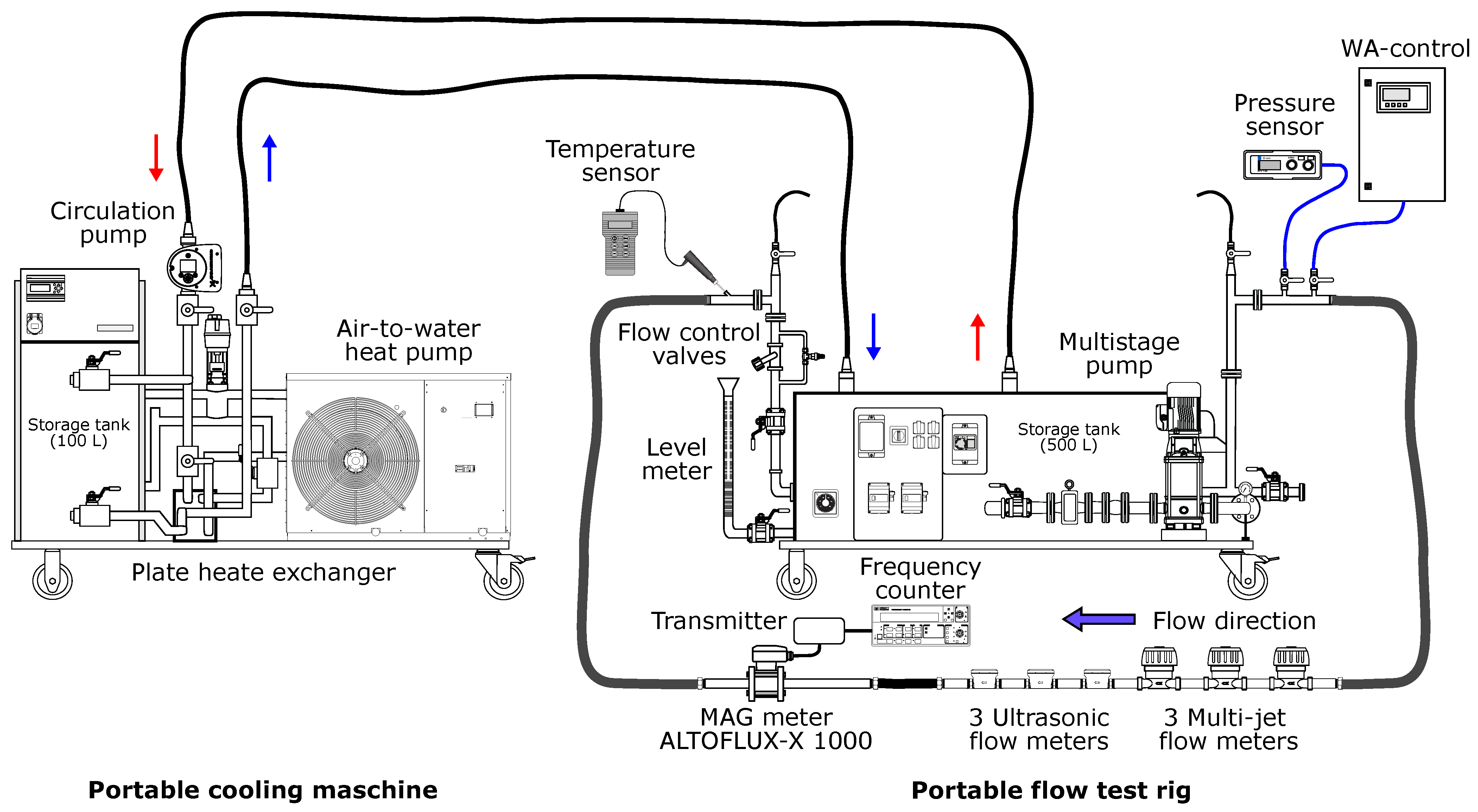
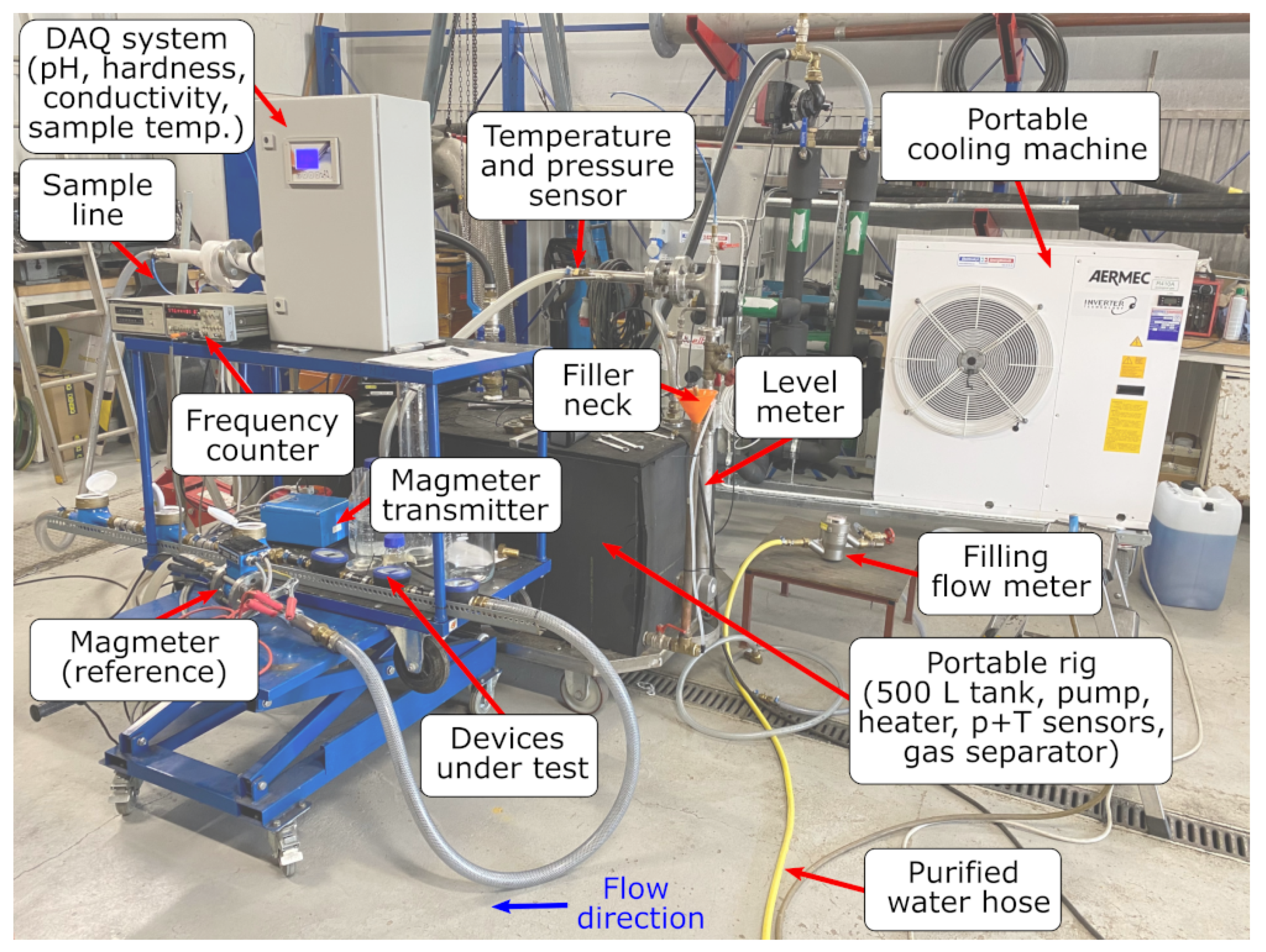
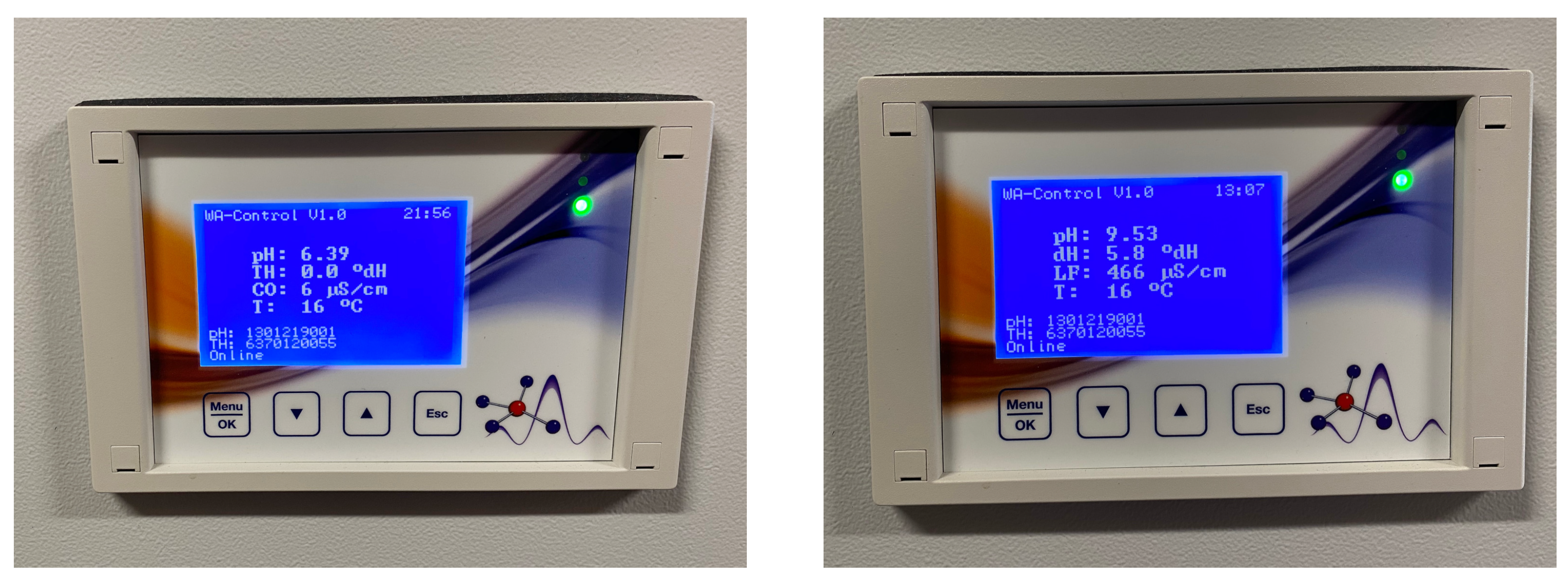
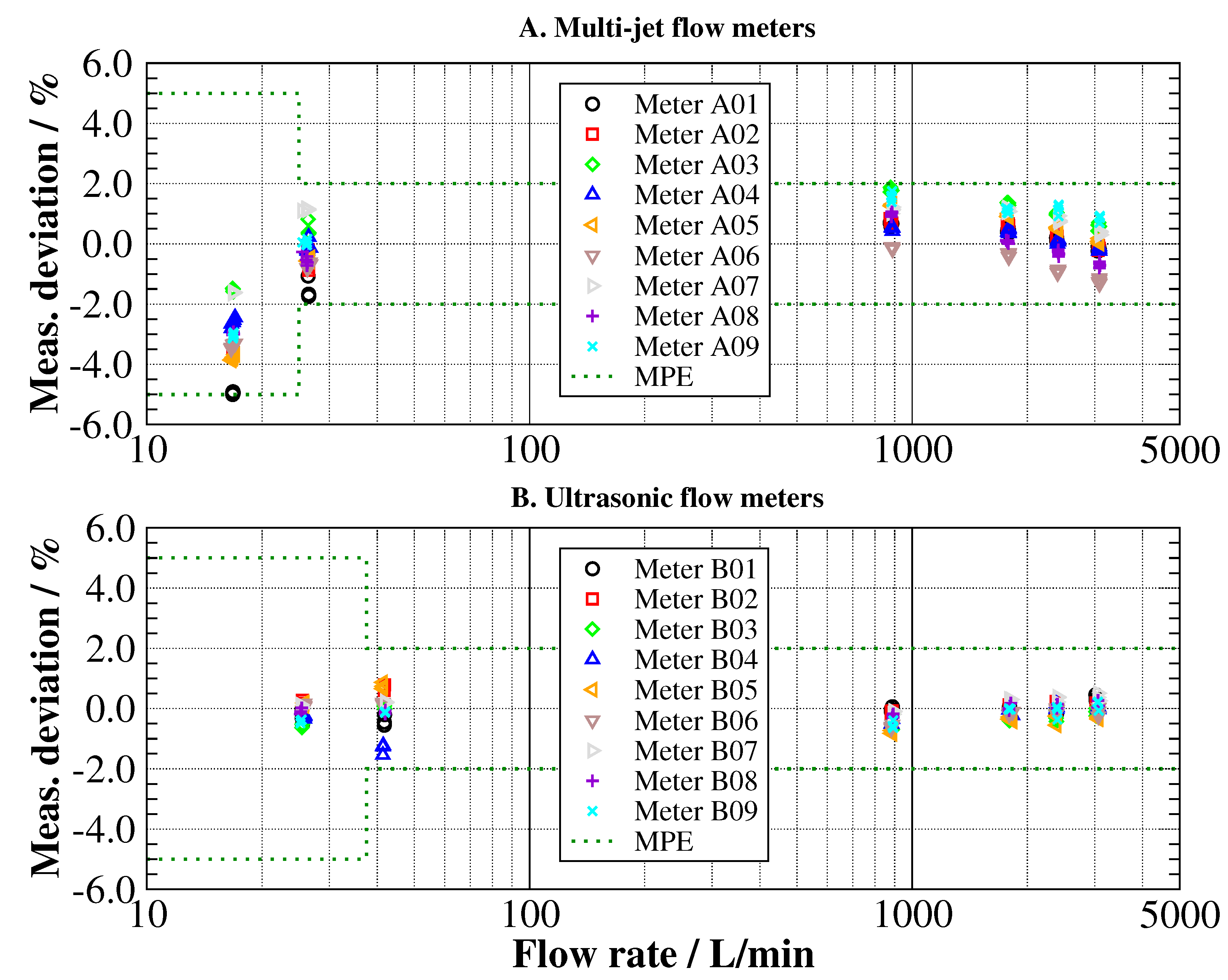
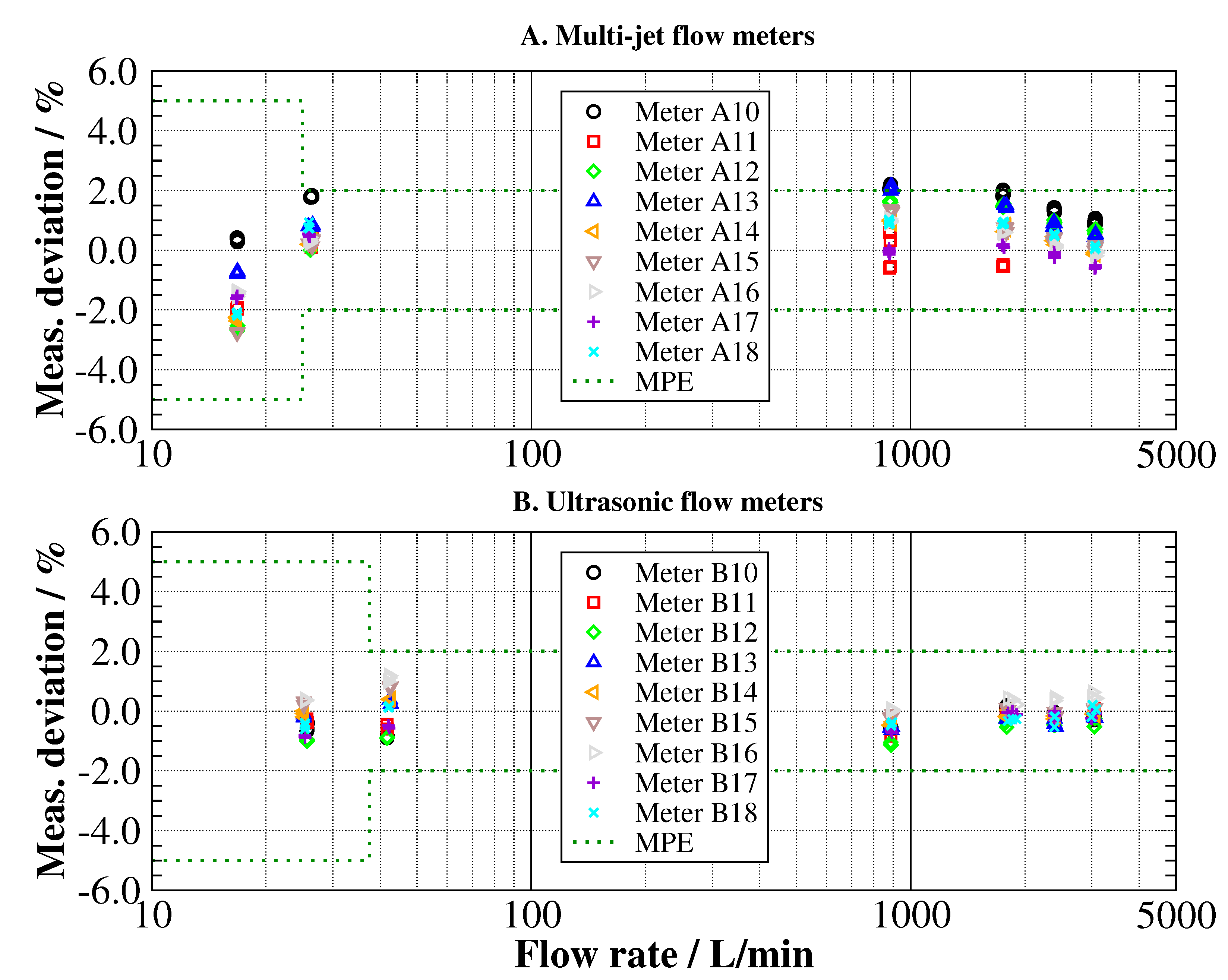


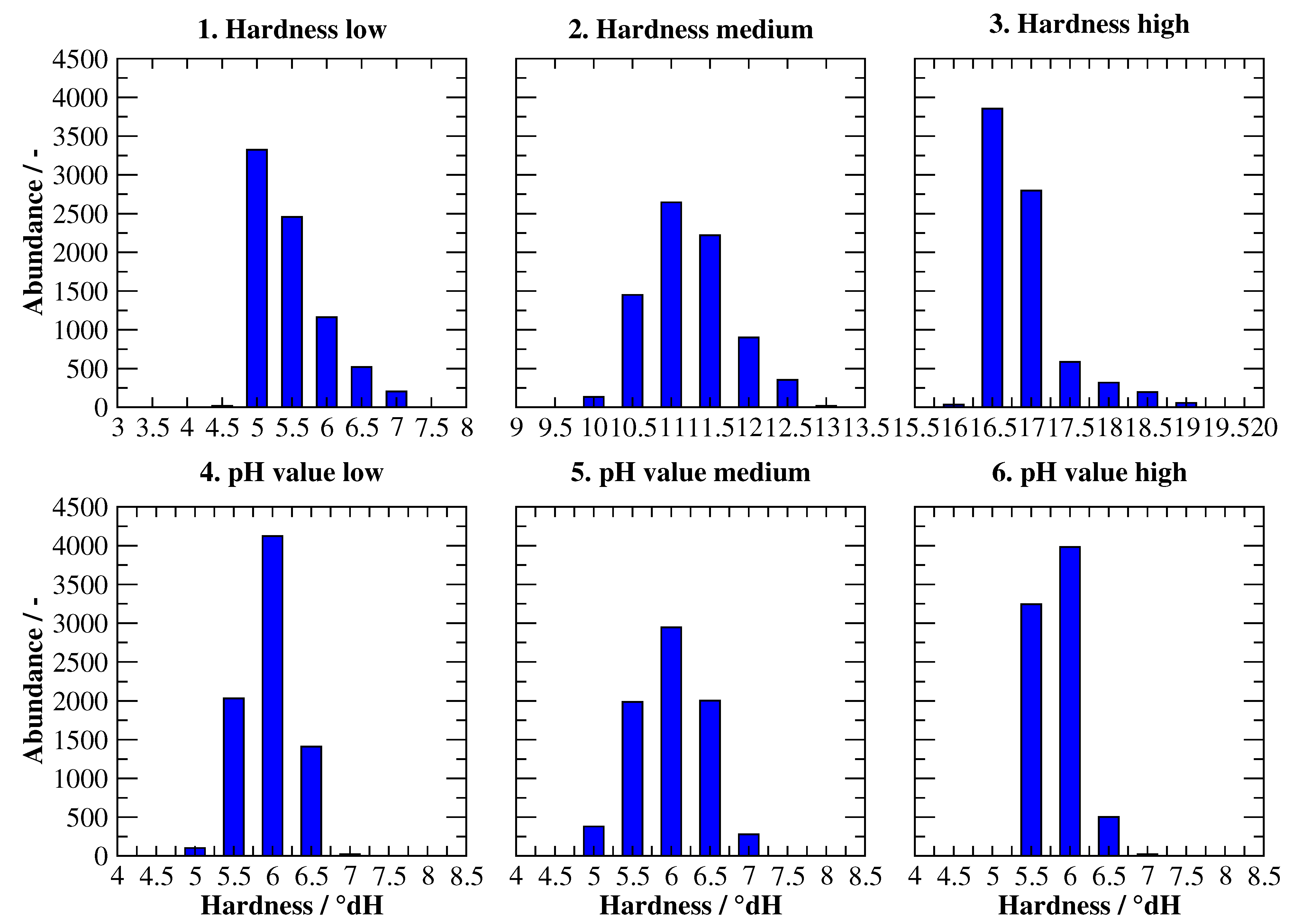


| ISO 4064 (Old) Earlier Version of ISO 4064 | MID (New) Current Version of ISO 4064 | |
|---|---|---|
| Nominal flow rate; given value | (n or N: meter designation) | |
| (Permanent flow rate ) | ||
| Measuring range; given value | to (); depending on | R with: R ≥ 40 |
| the metrological class A, B or C | ||
| Minimum flow rate | ; depending on the metrological class | with: |
| () | = with: (class A), | |
| (class B), (class C) | ||
| Transitional flow rate | ; depending on the metrological class | with: |
| () | = with: (class A), | |
| (class B), (class C) | ||
| Maximum flow rate | with: | with: |
| (Overload flow rate ) | ||
| Maximum Permissible Error | to : ±5% | to : ±5% and |
| (MPE) | to : ±2% | to : ±2% |
| Water Meter Size | Number of Residential Units |
|---|---|
| Flat water meter (individual level, 1 residential unit) | |
| House water meter: 1 to 30 residential units | |
| House water meter: 31 to 200 residential units | |
| House water meter: 201 to 600 residential units |
| Chemical Name | Chemical Formula | CAS Number |
|---|---|---|
| Calcium chloride | CaCl2 × 2H2O | 10035-04-8 |
| dihydrate | ||
| Magnesium sulfate | MgSO4 × 7H2O | 10034-99-8 |
| heptahydrate | ||
| Sodium bicarbonate/ | NaHCO3 | 144-55-8 |
| Sodium hydrogen | ||
| carbonate | ||
| Di-Sodium hydrogen | Na2HPO4 × 2H2O | 10028-24-7 |
| phosphate dihydrate | ||
| Potassium dihydrogen | KH2PO4 | 7778-77-0 |
| phosphate | ||
| Sodium hydroxide | NaOH | 1310-73-2 |
| Chemical Name | Concentration SL g L | Ion | Ion Concentration in SL g L | SL Dosing mL (SL)/L (MW) | Concentration MW mg L |
|---|---|---|---|---|---|
| Calcium chloride | Cl− | 41.9 | 21.0 | ||
| dihydrate | 86.9 | Ca2+ | 23.7 | 0.5 | 11.8 |
| Magnesium sulfate | SO42− | 30.4 | 60.7 | ||
| heptahydrate | 77.9 | Mg2+ | 7.7 | 2.0 | 15.4 |
| Sodium | |||||
| bicarbonate | 67.2 | HCO3− | 48.8 | 2.5 | 122.0 |
| Chemical Name | Concentration SL g L | Ion | Ion Concentration in SL g L | SL Dosing mL (SL)/L (MW) | Concentration MW mg L |
|---|---|---|---|---|---|
| Calcium chloride | Cl− | 41.9 | 44.6 | ||
| dihydrate | 86.9 | Ca2+ | 23.7 | 1.064 | 25.2 |
| Magnesium sulfate | SO42− | 30.4 | 129.3 | ||
| heptahydrate | 77.9 | Mg2+ | 7.7 | 4.256 | 32.7 |
| Sodium | |||||
| bicarbonate | 67.2 | HCO3− | 48.8 | 2.5 | 122.0 |
| Chemical Name | Concentration SL g L | Ion | Ion Concentration in SL g L | SL Dosing mL (SL)/L (MW) | Concentration MW mg L |
|---|---|---|---|---|---|
| Calcium chloride | Cl− | 41.9 | 68.4 | ||
| dihydrate | 86.9 | Ca2+ | 23.7 | 1.632 | 38.7 |
| Magnesium sulfate | SO42− | 30.4 | 198.2 | ||
| heptahydrate | 77.9 | Mg2+ | 7.7 | 6.526 | 50.1 |
| Sodium | |||||
| bicarbonate | 67.2 | HCO3− | 48.8 | 2.5 | 122.0 |
| Chemical Name | Concentration SL g L | Ion | Ion Concentration in SL g L | SL Dosing mL (SL)/L (MW) | Concentration MW mg L |
|---|---|---|---|---|---|
| Calcium chloride | Cl− | 41.9 | 21.0 | ||
| dihydrate | 86.9 | Ca2+ | 23.7 | 0.5 | 11.8 |
| Magnesium sulfate | SO42− | 30.4 | 60.7 | ||
| heptahydrate | 77.9 | Mg2+ | 7.7 | 2.0 | 15.4 |
| Sodium | HCO3− | 48.8 | 122.0 | ||
| bicarbonate | 67.2 | Na+ | 18.4 | 2.5 | 46.0 |
| Di-Sodium hydrogen | |||||
| phosphate dihydrate | – | – | – | – | 1370.0 |
| Potassium dihydrogen | |||||
| phosphate | – | – | – | – | 3340.0 |
| Chemical Name | Concentration SL g L | Ion | Ion Concentration in SL g L | SL Dosing mL (SL)/L (MW) | Concentration MW mg L |
|---|---|---|---|---|---|
| Calcium chloride | Cl− | 41.9 | 21.0 | ||
| dihydrate | 86.9 | Ca2+ | 23.7 | 0.5 | 11.8 |
| Magnesium sulfate | SO42− | 30.4 | 60.7 | ||
| heptahydrate | 77.9 | Mg2+ | 7.7 | 2.0 | 15.4 |
| Sodium | |||||
| bicarbonate | 67.2 | HCO3− | 48.8 | 2.5 | 122.0 |
| Di-Sodium hydrogen | |||||
| phosphate dihydrate | – | – | – | – | 1443.0 |
| Potassium dihydrogen | |||||
| phosphate | – | – | – | – | 258.0 |
| Chemical Name | Concentration SL g L | Ion | Ion Concentration in SL g L | SL Dosing mL (SL)/L (MW) | Concentration MW mg L |
|---|---|---|---|---|---|
| Calcium chloride | Cl− | 41.9 | 21.0 | ||
| dihydrate | 86.9 | Ca2+ | 23.7 | 0.5 | 11.8 |
| Magnesium sulfate | SO42− | 30.4 | 60.7 | ||
| heptahydrate | 77.9 | Mg2+ | 7.7 | 2.0 | 15.4 |
| Sodium | |||||
| bicarbonate | 67.2 | HCO3− | 48.8 | 2.5 | 122.0 |
| Sodium | |||||
| hydroxide | 80.0 | – | – | 0.17 | – |
| Parameter | Specification |
|---|---|
| Measuring method | Volumetric (prover or master meter) |
| Medium | Water |
| Flow rate | 0.1 −1 to 100 −1 |
| 6 −1 to 6000 −1 | |
| Temperature | 5 to 90 |
| Pressure | Up to |
| Measurement uncertainty | U |
| 1. Hardness | 2. Hardness | 3. Hardness | 4. pH Value | 5. pH Value | 6. pH Value | |
|---|---|---|---|---|---|---|
| Low | Medium | High | Low | Medium | High | |
| Target values | ||||||
| pH value | – | – | – | 6.50 | 7.70 | 9.50 |
| Hardness () | 5.6 | 11.2 | 16.8 | – | – | – |
| Measured values | ||||||
| pH values mean | 7.87 | 7.65 | 7.66 | 6.49 | 7.69 | 9.50 |
| pH values Std Dev | 0.11 | 0.03 | 0.02 | 0.04 | 0.07 | 0.04 |
| Hardness mean () | 5.3 | 11.0 | 16.7 | 5.7 | 5.8 | 5.6 |
| Hardness Std Dev | 0.5 | 0.5 | 0.5 | 0.3 | 0.4 | 0.2 |
| Conductivity mean ( cm−1) | 380.6 | 571.4 | 752.5 | 2660 | 1684.7 | 501.3 |
| Conductivity Std Dev | 1.1 | 2.1 | 3.9 | 0 | 6.6 | 25.2 |
Publisher’s Note: MDPI stays neutral with regard to jurisdictional claims in published maps and institutional affiliations. |
© 2021 by the authors. Licensee MDPI, Basel, Switzerland. This article is an open access article distributed under the terms and conditions of the Creative Commons Attribution (CC BY) license (https://creativecommons.org/licenses/by/4.0/).
Share and Cite
Büker, O.; Stolt, K.; Kroner, C.; Benkova, M.; Pavlas, J.; Seypka, V. Investigations on the Influence of Total Water Hardness and pH Value on the Measurement Accuracy of Domestic Cold Water Meters. Water 2021, 13, 2701. https://doi.org/10.3390/w13192701
Büker O, Stolt K, Kroner C, Benkova M, Pavlas J, Seypka V. Investigations on the Influence of Total Water Hardness and pH Value on the Measurement Accuracy of Domestic Cold Water Meters. Water. 2021; 13(19):2701. https://doi.org/10.3390/w13192701
Chicago/Turabian StyleBüker, Oliver, Krister Stolt, Corinna Kroner, Miroslava Benkova, Jan Pavlas, and Veit Seypka. 2021. "Investigations on the Influence of Total Water Hardness and pH Value on the Measurement Accuracy of Domestic Cold Water Meters" Water 13, no. 19: 2701. https://doi.org/10.3390/w13192701
APA StyleBüker, O., Stolt, K., Kroner, C., Benkova, M., Pavlas, J., & Seypka, V. (2021). Investigations on the Influence of Total Water Hardness and pH Value on the Measurement Accuracy of Domestic Cold Water Meters. Water, 13(19), 2701. https://doi.org/10.3390/w13192701






